#Like think about masculinity- both in general but also in the terms of OP's story
Explore tagged Tumblr posts
Text
God I wish I could remember what Oda once said about mothers in One Piece... I can't remember if it was about Luffy's mother in particular or moms in general, but he essentially joked about how you'd have to be A Really Horrible Mother to allow your child to go off and become a pirate (dangerous business no loving mother would allow)
And just... My vague memory of that comment is living in my head right now, because truly, if Crocodile somehow is Luffy's mom, truly nothing would make him a worse mom than
Literally trying to murder his child and beating him to near death multiple times the first time they actually meet
Going so far to stop being a mom that he became a dad instead
#Moon posting#Honestly I can't help but to feel that if the theory is true I don't think Crocodile has any positive feelings about Luffy#Like I don't think he'd see Luffy as his child or. Anything#Like the vibe I get is that Luffy to him would be nothing more than something from a past life he wants nothing to do with#And a past version of himself he wants buried dead and forgotten#Like think about masculinity- both in general but also in the terms of OP's story#The way some cishet men react to the mere concept of Trans Croco and the way they're ready to dismiss him as a ''real man''#Like. Fragile Masculinity makes it so that if you aren't performing your manliness at 1000% at all times you aren't manly#That's why it's fragile. It's all or nothing. And so if Crocodile was FtM many would see him as just the F. They'd just ignore the ''tM''#Crocodile did not seem like he wanted to be associated with Iva-chan or any of the newkama AT ALL#If he is trans then he is fully stealth. He does not want to be outed. He does not want to have his manhood questioned.#His past could instantly be used to turn him into a laughing stock. He'd have to deal with transphobic attacks and misogyny#So if he just wants to live his life in peace then he could just see his past as a potential threat to his future#Anything about who he might've been could be used against him#That includes the husband he divorced. That includes the child he abandoned.#They aren't anything to Crocodile but something he wants nothing to do with.#And he's willing to go so far as to kill that child to tie up any loose ends#Which sounds horrible but he did attempt to kill millions with a massive bomb so like#Yeah. Sir Crocodile ain't winning Dad of the Year award anytime soon. He does not give a shit about his son.#Crocodile looked at Shinji Evangelion and figured he could have a worse father-son relationship. And he's winning that contest#Of course this reading is absolute bonkers and I doubt Oda could write a trans character with this kind of nuance#It just makes sense to me alright#And I have brainworms#And if I'm being realistic I only think there's a 30% chance the Crocodad theory is actually canon#Trans Croco in general get's a 70% because. You don't give this guy some Secret Beef with the Magic HRT Person like that#Again I just think it'd be fucking funny if he was Luffy's dad#It is 6 am I am not proof reading any of this shit
30 notes
·
View notes
Text
All of this, and some more thoughts:
First, just to be clear, nothing here is disagreeing with you at all op, especially not saying you shouldn't love and enjoy the designs that speak to you. I'd just like to expand on your ideas with some thoughts I've had about masc Murderbot designs, why people make them, and maybe some more ideas about what bothers people about them.
One of the reasons I find this trend interesting is that it runs counter to the very common trend of assuming that genderless/agender = woman lite. But the majority of Murderbot designs I've seen don't fit that mold. So, why is this that?
A couple things may go into it:
Both versions of the audiobooks have MB narrated by a man with a relatively low voice. For people (even trans people!), the immediate association there is with a man/masculine character, even if those people would never say that, eg, a trans woman with a deep voice is less of a woman for it.
(And this may be an even bigger element for a lot of people) Murderbot's personality and the role it plays in the story both fit a stereotypical mold for male characters. It's snarky, emotionally constipated, a bit of a loner, physically powerful, and does a lot of combat. Don't get me wrong here! I'm not saying that any of those things are inherently masculine, just that they are traits that are, in conventional storytelling and most of the media that people have experience with, almost exclusively given to men. Even if a woman/nonbinary person has those traits, they're usually portrayed visually as very masculine or those things are set up as being deeply incongruous with their appearance. (This one is especially apparent in the hmmm... less trans focused... segments of the fandom where, you may have noticed, people have an (infuriating) tendency to misgender MB as he/him, but I have yet to hear someone refer to it as "she.")
And so, to a lot of people, Murderbot immediately reads as masculine, even though there is nothing about any of the stuff above that is inherently tied to being masc/a man.
Now, I am in complete agreement with OP here that this is all absolutely fine! More masc nonbinary or agender characters is a fantastic thing that we need in media.
Simultaneously, we could also use more characters who are not masc in appearance who have those same traits! And for people who really want to see more of that, especially to see themselves reflected in that way, the majority of Murderbot designs being masc can be frustrating. A lot of people have similarly expressed a strong desire to have a version of the audiobooks read by someone with a different sort of voice, and I think that would be excellent as well.
All of that being said, we can and should 100% focus on uplifting and appreciating all these different artists and their ideas! This is a character who means so much to so many people in so many different ways, and as a fandom we have so so so much space to create and celebrate that diversity (with all the characters tbh. Martha Wells, intentionally or not, gave us such a gift by not describing anyone's appearance in any amount of detail).
(Ok, last note here: I am using the terms "masc" and such in a way that references the way that people in general perceive things, not as an absolute statement about what things actually are. Just to be clear there).
Okay so, I've been sitting on if i should make this post or not for a while but with some of the tags I saw on a recent post mentioning the same thing, I decided to go ahead and say my piece: in my own words:
I've seen some posts in the main tags essentially saying something to the effect of "why do people always draw MB as masculine and not androgynous"
As someone who, like Murderbot, does not have a gender (rather, in my case, associate with one) this always rubs me the wrong way and makes me feel a bit bad about my own identity, which suck because to me, this fandom is a safe space to speak of gender, sexuality and a slew of other things. Like I said, I am gnc, afab in fact; but I look like a guy, I like looking like a guy, I actively try to look like a guy... but i am not a guy. I dont feel like a guy, i just like looking like one. That doesn't mean my identity as a nonbinary/gnc person is suddenly erased because I don't fall under your narrow minded idea that all nonbinary/gnc people need to be androgynous.
I don't owe you perfect androgyny, no one owes you any level of androgyny.
MB is a fictional character with next to no physical descriptions; its not hurting anyone if someone sees it/draws it as masculine or even feminine. You don't get to dictate how people see it, especially when they base it's appearance on themselves
581 notes
·
View notes
Text
My Oriented Aroace Headcanons From 8 Fandoms
Oriented Aroace is an aspec identity where someone does not experience sexual or romantic attraction but experience other forms of attraction in a way that causes another nonaspec label describing sexuality to feel significant enough to have a place alongside one’s aroace identity. For more information on this term, here is the info page on the oriented aroace subreddit and here is the wiki page on it.
Headcanon is a subbranch of fanon, meaning headcanon is something generally not accepted as canon but some fans choose to believe about the original content. In the queer community, it is common to headcanon characters as queer. Sometimes it’s with good reason, sometimes it’s just because we like the characters, sometimes it’s because we see something of ourselves within the characters.
Here are some of my oriented aroace headcanons.
1. Sai (Naruto)
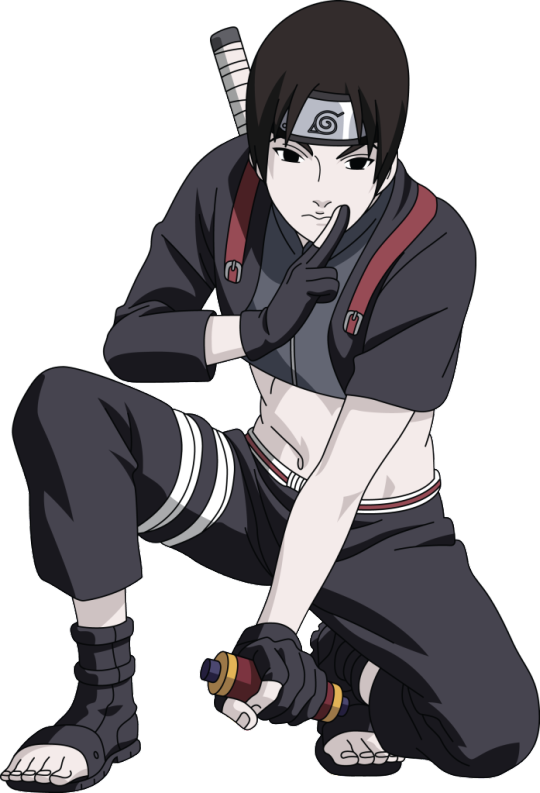
This is by far my favorite aroace headcanon but I don’t talk about it much because I don’t want to support the stereotype that aromantics are heartless or that asexuals are traumatized. In Naruto Shippuden, Sai is a character who does not experience emotions after an illegal black ops organization killed his brother and brain washed him. He does, however, recover his emotions and learns to be very in touch with them. In Boruto, he is married to Ino and has a son named Inojin.
I headcanon Sai as pan-oriented aroace, possibly demialterous as well, but he experiences some degree of internalized homophobia and aphobia which leads him to pursue a romantic relationship with Ino. I don’t doubt that he loves her, he definitely does but I don’t think he loves her in the same way that she loves him. I wrote about this for Aromantic Writing Month. I believe that Sai initially started courting Ino because that was what was expected of him. Ino went along with it because she is attracted to him. At some point she probably realized Sai doesn’t quite feel the same way as her but they talked about it and continued their relationship as a allo-aspec qpr.
2. Rook Blonko (Ben 10)

Rook Blonko is Ben’s (work) partner in Ben 10: Omniverse. He is an alien from the planet Revonnah. When we see his homeplanet, we learn that he is very attractive by Revonnahgander and all the local girls are interested in him but he is bothered by it, only showing affection for one girl named Rayona. They end up dating later in the series. A couple villains show interest in Rook as well and he is usually bothered by it or has mixed feelings with no desire for reciprocation.
I headcanon him as hetero-angled aroace, specifically gray/ frayromantic and acespike. Gray romanticism means that someone is aromantic but can experience some kind of limited romantic attraction or experiences romantic attraction under specific circumstances. Frayromantic is essentially the opposite of demiromantic. Someone may experience romantic attraction that fades as they get to know the other person. Acespike means that someone is asexual but can sometimes experience spikes of sexual attraction.
If you have seen the show, you may know where my thoughts are coming from. Rook mostly shows romantic interest in Rayona before they start dating. Once they’re in a relationship, their feelings seem very platonic and their relationship is much like a qpr. This may be because of their age, lack of experience, or their culture but I’d like to imagine that Rayona feels the same way as Rook and they are in a qpr.
The only other character Rook has shown interest in is Isosceles Vreedle. He is briefly attracted her during a battle but doesn’t seem to have any intent on acting on his feelings (presumably because he is in a relationship). He seems to be aware that this is out of character for him, which leads me to believe that he is acespike.
3. Alain (Pokémon)
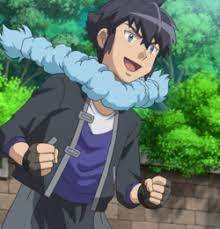
Alain is the star of the Mega Evolution specials and Ash’s main rival in the Kalos League. I headcanon him as gay-oriented aroace.
I don’t have much of a reason for this. Headcanons don’t necessarily need reasons but I’m still going to try to explain this one.
He never has any romantic interests in the show, probably because we don’t see much of him and his story is very focused on his Pokémon training. There are many characters who are solely focused on Pokemon training and that doesn’t necessarily mean they’re aroace but with Alain, I can’t really see him ever wanting to settle down or pursue a relationship though and he doesn’t seem like a women’s man.
His perfect life is retiring young from a decent battle career on a Pokemon ranch where he works as a Pokemon professor, giving out starter pokemon and providing a place for trainers to send their pokemon when their parties are full. He won’t have many visitors but maybe he’ll have a close companion to keep him company and help out with any projects he’s working on.
4. Toph (Avatar: The Last Airbender/ The Legend Of Korra)

Toph is Aang’s earthbending teacher in ATLA, the founder of metalbending in the comics, and Lin and Suyin’s mother in TLOK. I headcanon her as sapphic or trixic-oriented aroace.
Sapphic and trixic are both non-exclusive terms for attraction to women but sapphic is specifically for women and trixic is for non-binary people. Canonically, Toph is a girl but she is very free spirited and independent and I feel like she wouldn’t let something like gender limit her.
In TLOK, Toph does mention that she tried to have relationships with Lin and Suyin’s fathers but it didn’t really work out. I imagine that Toph is sex favorable and likes sex as kind of a fun way to enjoy herself but does not experience sexual attraction nor does she feel a need to have regular partners. Similar goes for romance. She is romance-indifferent but does not like it much.
The lesbian Toph headcanon is a popular one. Not really sure why but Toph seems like a ladies’ woman. She likes to have her fun and she just finds women to be better companions than men in these aspects. She doesn’t get attatched easily though and she’s not really into the commitment.
5. Korvo (Solar Opposites)
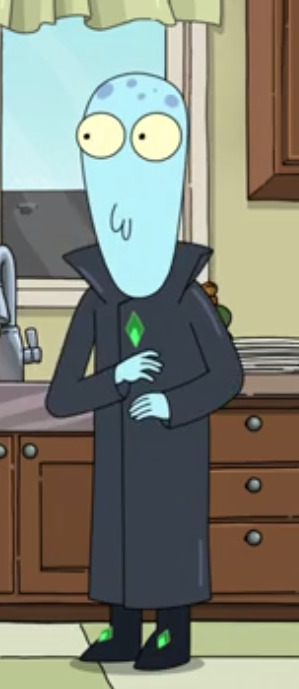
Again, I feel like this plays into a stereotype that I don’t want to support but these are my headcanons and I will do with them as I want. Korvo is an alien who is having a hard time adjusting to living on Earth. We know that his species has no biological sex and do not reproduce sexually but many of them choose genders, enjoy sexual activity, and pursue romantic relationships. I headcanon Korvo as bi-oriented aroace, possibly bi-electio aroace.
I have not seen the most recent season but in season 1, Korvo is mostly uninterested in anything outside of returning the ship. We have seen him in real no romantic contexts but he and Terry are co-parents of sorts. We also see him in a couple of sexual contexts. When he got zapped by a ray that removed his intelligence, he tried humping Terry and when he and Terry tried going to college, he remained on his side of his and Terry’s shared bed when Terry brought home sexual partners.
I don’t think Terry and Korvo are in a relationship or a qpr but am not completely opposed to the idea. My point was just that we know he isn’t repulsed by the idea of doing traditionally romantic or sexual things with someone who is masculine in nature. I think he could also appreciate what a woman brings to the table, as seen when he built a robot to fulfill the role of wife and mother in the house.
I don’t think Korvo is interested in a relationship but he does value the companionship and wouldn’t be unhappy with a partner. He may struggle to maintain a partnership but I don’t think gender would be much of a factor.
6. Todd Chavez (BoJack Horseman)

Todd is BoJack’s off-and-on best friend/ roommate. Canonically, he is asexual and heteroromantic (presumably, all we know for sure is that he is alloromantic). I headcanon him as straight-oriented aroace, specifically heteroqueerpatonic and panplatonic.
I love that Todd is canonically asexual and I appreciate that they showed an asexual character who is not aromantic. But, all of Todd’s relationships have that queerplatonic vibe. When he described the kind of relationship he wanted with Emily, it didn’t sound like a romantic relationship. What he had with Yolanda certainly wasn’t romantic. Maybe it was just the writing but Todd seemed most happy when his relationship resembled a qpr. When he was dating Maude, the lines between romance and friendship were blurry and they seemed very happy, and that included not doing traditionally romantic things like getting married.
I could also see Todd as greyromantic. For him, I feel like having a label isn’t really that big of a deal. Being able to say he was asexual was a big deal for him but he just wants to be himself and find whatever makes him happy. Sex and a traditional romantic relationship don’t really seem to be a part of that.
7. Silver Surfer (Marvel Comics)

Again, this isn’t one I talk about much because I don’t want to support the stereotype that aromantics or asexuals are inhuman or lacking emotion. Before becoming the Silver Surfer, Norrin Radd is in a relationship on his home planet and he does express interest in a few women after becoming the Silver Surfer. I headcanon him as straight-oriented aroace.
Some of it may have to do with Galactus’s interference. Maybe not. The Surfer doesn’t need sex or romance (no one does but you catch my drift) but he doesn’t really want it either. Sometimes it is portrayed from a sense of duty but we don’t really know what he’s feeling. He’s been one of my favorite characters for years so I may just be projecting but it feels right.
He can get lonely. He wants a companion but I don’t think he’d want a romantic one or even a queerplatonic partner. He’d be most happy with a friend and he’d get all the fulfillment he needs from one. A romantic partner might be a bit too much.
8. Gina Linetti (Brooklyn 99)

Gina is Jake’s childhood friend, Captain Holt’s assistant, and Boyle’s... something. I’ve seen a lot of headcanons that she is pansexual but I headcanon her as heteroflexible-oriented aroace.
Gina, like Toph, is just kind of doing her own thing. I feel like she’d be sex favorable and romance indifferent. Sex is fun, relationships are alright, she’s just living her best life. Men are nice, women are too. She’s just living life and rocking with whatever rolls her way.
When she has her daughter, she does want to settle down a bit but not with a man. She loves the kid and steps up to her new responsibility but she doesn’t let it change her. She’s still as wild and free and she doesn’t want or need anyone.
#oriented aroace#asexual#aromantic#ace#aro#asexuality#aromanticism#aroace#head canons#queer headcanons#queer#lgbt#lgbtq#lgbtqa#lgbtqia#naruto#naruto shippuden#sai#sai yamanaka#naruto sai#ben 10#ben 10 omniverse#rook blonko#pokemon#pokemon anime#pokemon xy#mega evolution#pokemon mega evolution specials#pokemon alain#atla
17 notes
·
View notes
Photo

“Chalk One Up” | Directed by Seith Mann, Cinematography by David Klein
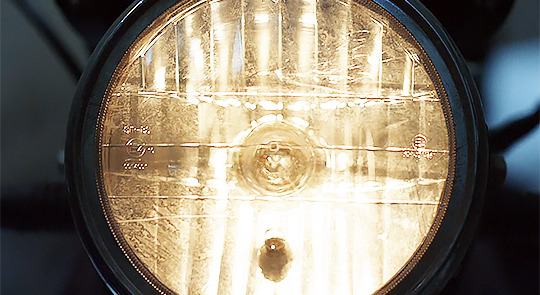
The episode opens with Carrie arriving from a long night out doing… God knows what with God knows who. We love the starkness of this close-up on the exterminated motorcycle light. According to Lesli Linka Glatter, this mode of transport is based on a real life story:
“The scene where she gets out of the embassy was based on the real agent who Carrie is based on. She was based in Iraq at the time and that’s how she got out: by dressing as a man and traveling on a motorcycle. So, we used that for this. Also, you can’t leave in Kabul without an armored vehicle.”
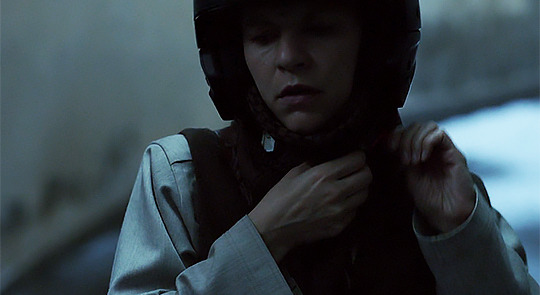
...as the camera slowly pans up to reveal it’s Carrie underneath that (gigantor) motorcycle helmet, the question becomes clear: where the fuck was she?
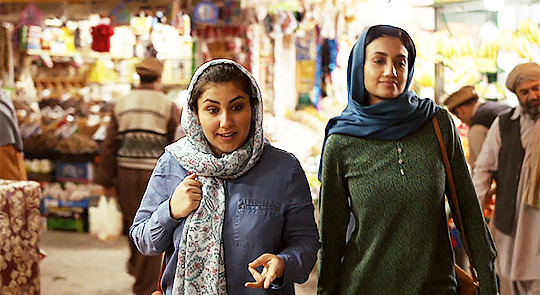
Sara loved these scenes between Samira and her friend. Homeland has depicted several cities in the Middle East over the years but has rarely given us glimpses into the world outside the walls of a hotel or CIA station, especially without our main characters. The market that Samira and her friend walk through is vibrant and filled with color, as are their outfits. It’s a stark contrast to the interiors of the CIA station. And Samira’s line that the Taliban didn’t go away but were no longer hiding proves remarkably predictive of the rest of the episode’s events.

The real highlight of the scene is the selfie, of course. We love the detail of the man on the far, far left being cut out. Samira’s friend is the master of the one-arm selfie!

This shot of the various players at the Kabul station looking outward at Carrie is striking. It’s almost a reverse fish bowl. Carrie remains on the outside but everyone’s looks are in her direction. Jenna standing at the front of the room further suggests she was never “stuck in the starting gate.” She’s in the same position of power in that room as the Chief of Station and the commanding military officer at right. From afar, the dynamics are almost similar to early season one, Carrie running an ops meeting with Saul by her side. All of which is to say… is Jenna the Carrie to Mike’s Saul?

Dog.
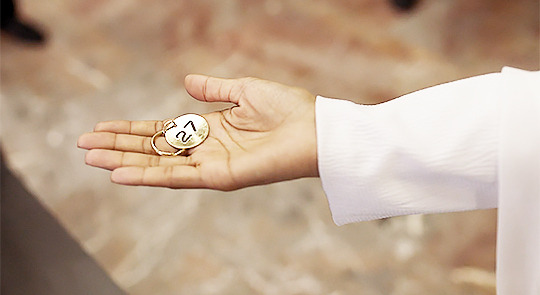
This was such a specific detail that we thought it required pointing out, but 27 is not a significant number on this show (at least that we can remember), so we’re not sure why they bothered to show this.
...unless it’s a reference to the general ominousness of the 27 Club and a hint that Carrie (who, to be fair, is far past the age of 27) is going to die.
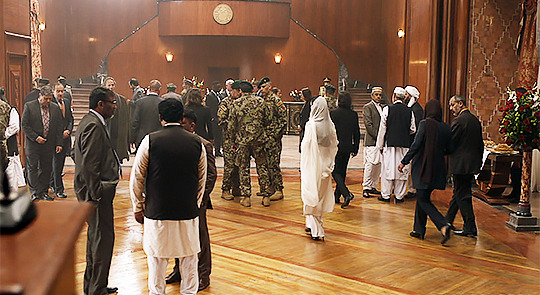
This week the show confirmed that Tasneem is the Director of the ISI. Which means that (after President Elizabeth Keane) she’s the second most powerful woman ever depicted on this show. And boy does she dress the part!
Tasneem’s all-white ensemble is attention-grabbing and distinctive (the other women in this frame are dressed in dark clothes). It’s also visually similar--especially with her long, black hair peeking through the sheer fabric of her headscarf--to the dress worn by several other men at the reception.
Homeland has told lots of stories over the years--whether intentional or otherwise--about the challenges women face living in a patriarchal, misogynist society. Whether it’s Martha losing her career because her loser husband couldn’t stand having a wife who was more powerful and smarter than he…. Or Allison dying in the back of a car near the Russian border in an act of scorned lover revenge. Or Carrie, screaming and crying at the end of “The Vest”... but being right the whole time.
Or, as Abigail Nussbaum said more elegantly than we ever could:
“Carrie is, in many ways, a boogeyman; she is what professional women, and particularly ones in male-dominated professions, have been taught never to become - emotional, hysterical, crazy. Emotion is how women who want to be taken seriously are undermined and dismissed. Even if you’re perfectly sane, being emotional - and most especially, being angry - devalues you and your professional contribution. A woman can be called crazy simply for behaving like a normal human being rather than a robot (and of course, if she behaves robotically and unemotionally, she’s a cold bitch). But Carrie isn’t simply emotional (though she is that too, and worst of all, she allows her feelings for a man to cloud her judgment) - she actually is crazy and hysterical, in the proper clinical sense rather than the exaggerated one which attaches to any feminine display of emotion, and profoundly pathetic and unattractive in that state. And she’s completely right, the only person who figures out Brody and Abu Nazir’s plans and motivations, and the person who saves the day by being hysterical, infecting Brody’s daughter with enough of that hysteria that she calls her father and convinces him not to blow himself up.
It’s certainly possible to read this arc as purely tragic, Carrie’s self-destruction being the cost of saving the world (though this is a character arc that is applied to men as often as women, for example in Thomas Harris’s Red Dragon), but to my mind its effect is more complex. It makes a crazy, hysterical woman into a hero without in any way mitigating her craziness or hysteria, and thus defangs the argument that emotion in women is a weakness. It’s the rational, sane men around Carrie, who turn away from her unattractive mania with distaste and embarrassment, who are blind and incompetent, and it’s that same inability to look past surfaces that leads them to put their trust, wrongfully, in Brody - just as Carrie performs hysterical femininity, Brody performs stalwart masculinity. Both are misleading.”
All of which is to say, we’re really fucking pumped to see how Tasneem’s role expands for the rest of the season, and we think the array of women in Tasneem, Carrie, and Jenna and their varying degrees of power is going to be really interesting to see unfold.
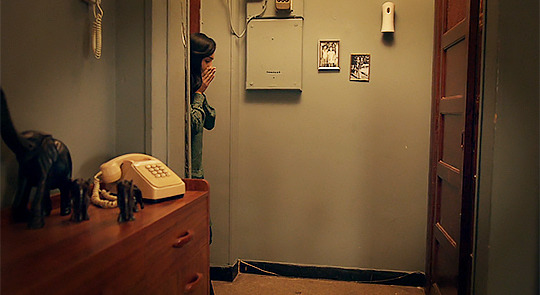
Sara is obsessed with this shot. She’s obsessed with the set design of Samira’s apartment. She’s obsessed with this moody lighting. She’s basically just obsessed.
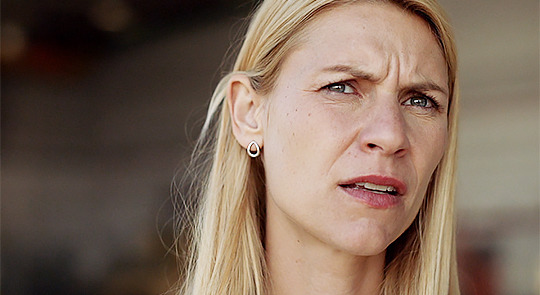

Last week we had a slow pan around Jalal to reveal Tasneem. This week we have a similar slow pan around Carrie to reveal Jenna. This definitely means that Sara’s theory that Jenna will “single white female” Carrie is right on track.
Also, Gail hereby declares Carrie’s delicate silver jewelry her “FULL circle earrings,” because everything is coming full circle this episode, including accessories.

That said, we can’t deny the power of this shot. First, we have to note what’s going on in the background (which is actually in focus). President Beau has just arrived off Air Force One and immediately stops for a photo op with the Afghan president. From the beginning, the show is clear this is an optics-based trip.
But we really love this image of Carrie and Jenna (out of focus, but in the foreground) side by side. Again, they mirror each other, but in opposite ways (“So they’re mirror opposites?” --Sara’s brain). Carrie’s light hair versus Jenna’s dark hair. Jenna’s light jacket versus Carrie’s dark one. It’s eerie.


On the podcast we talked at length about the scene between Beau and Carrie. It’s genuinely moving. The staging of it is unique as well. The camera shoots them both at the same height. They stand close together. Ironically, the power dynamic seems almost equal. He’s one of the few people who’s ever acknowledged the sacrifices she’s made in service of her country.
Their twin smiles here are all the more tragic following the sequence of events that closes the episode. They all sincerely want peace. So many characters smile real, genuine smiles this week. That’s not a normal Homeland occurrence!
And they all legitimately believe in what they’re doing. They believe they’re doing the right thing. Maybe they are. But partly out of necessity, and partly out of more selfish desires (Hayes later says it’s all about getting a second term), they get caught up in the theater of it all. They make poor decisions. They take the wrong risks.
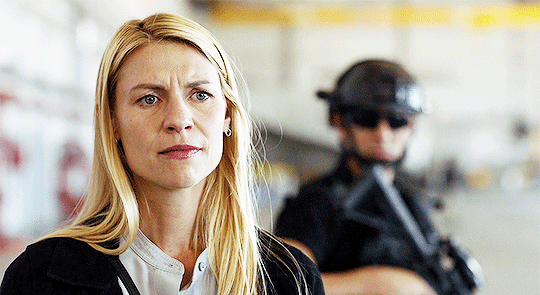
Every so often in this series we have to abandon screenshots in favor of gifs in order to truly capture ~the moment~ and this is one of those times! The way Claire plays Carrie’s reaction here is so specific, so nuanced and strange and wonderful. These “lived in” moments are something we’ll really miss when the show is over.

IJLTP.

We’ve all been there, Carrie.
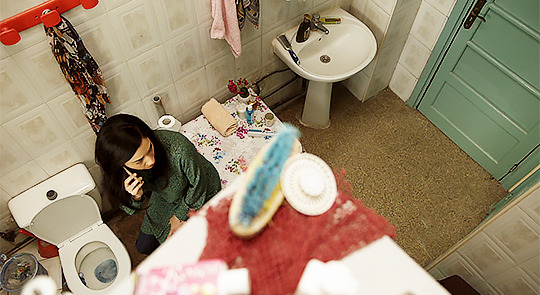
This is another interesting shot choice. We’re not sure what its purpose is, other than to add interest to a fairly run-of-the-mill scene. But still, the set design! *heart eyes*
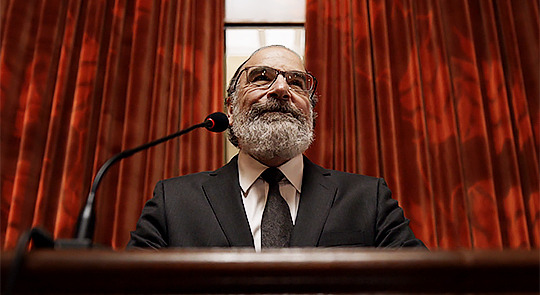
Sara’s note for this shot was “Saul is so extra.” We talked about genuine and sincere smiles above and Saul’s here does qualify… sort of. This is halfway between genuine and self-aggrandizing. AKA “where Saul lives 100% of the time.” He looks like a director about to screen his short film at Sundance. The red curtains parting slowly behind him are Too Much.

Tasneem and G’ulom are the kids in the back of the classroom who are so fucking done with this shit but can’t leave because they’ll get detention. We will continue to stan.
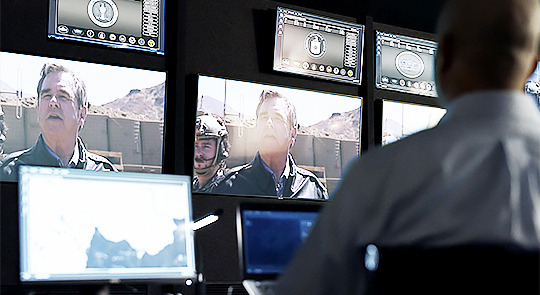
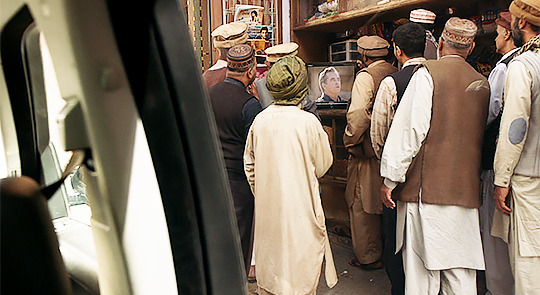
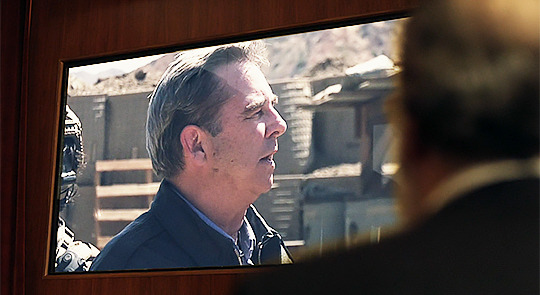
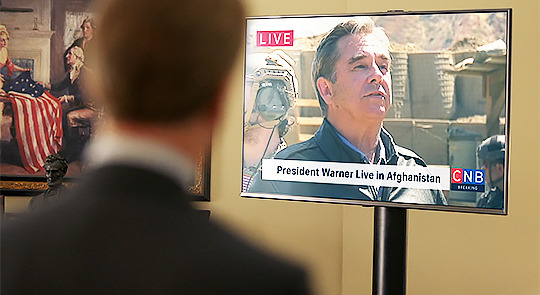

It’s a classic Homeland device to show a significant moment from a variety of perspectives, especially if those perspectives involve screens. The multitude of angles on Beau’s speech here reminded us a lot of Keane’s resignation speech in the Oval Office in “Paean to the People.” Coincidentally, that was her last hurrah as president too.
(P.S. Another Saul over-the-shoulder shot!)

Two selfies in one episode!


We loved the payoff to Max’s subplot. For once this season the weird LA filter actually looks nice! These are beautiful shots and the reflection in Max’s glasses is especially striking.
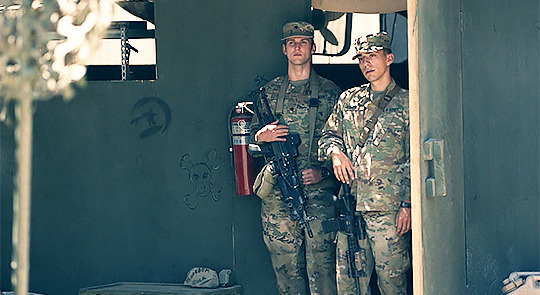
The skull and crossbones on the barracks is an ominious detail. As is the rock labeled “Boredom Rock.” Death and boredom really have been the two extremes of Max’s stint at the combat outpost.

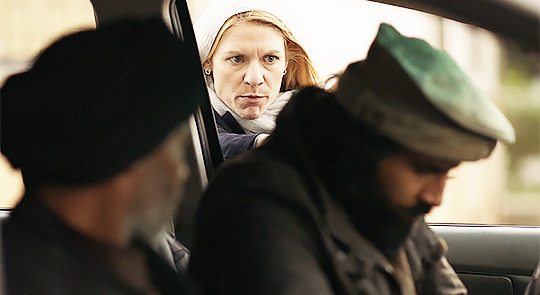
We’re still divided on the merits of the “Carrie has to save Samira” storyline, but the camerawork here, with Carrie’s armed hands appearing out of nowhere, was pretty cool.

This RPG shot was one of the cooler special effects the show has done in a while. The entire sequence of Chalk One looking for Chalk Two was tense and thrilling and extremely well-executed.

Bringing us back to the ops room, the “LOSS OF SIGNAL” projected now for both helicopters is pretty chilling.
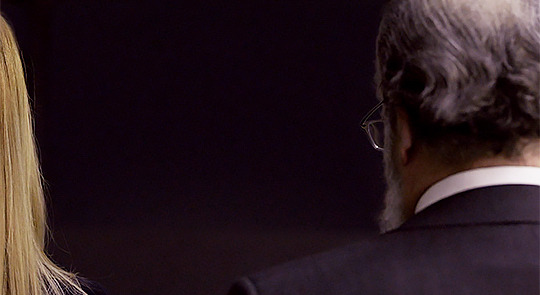
This is now Sara’s favorite shot of the entire series and we’d be remiss if we didn’t mention that it’s another over-the-shoulder Saul shot. This time he observes one of the crowning achievements of his long career literally blowing up in his face.
Visually, this shot anchors the viewer back to the Carrie/Saul relationship, the central one of the show. The black blankness--and the failure it represents--engulfs the frame.
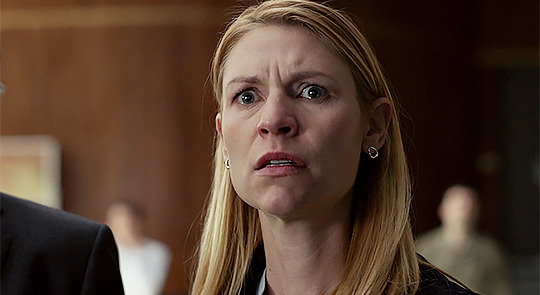
We love the choice to end the episode on Carrie alone. It refocuses the event back to her. The horror in her eyes, welling up with tears, is palpable. How does Carrie feel? Alex Gansa explained that the writers wanted to create a new 9/11 with this maybe-assassination of the president. And it’s a fitting bookend for the show in many ways. In Homeland’s pilot, Carrie says she “missed something that day,” misdirecting blame to herself for not preventing 9/11. Now, in the final season, the show seems poised to tell a story in which Carrie is blamed for the “new 9/11.”
Strap in, folks. It’s gonna be a rough ride.
2 notes
·
View notes
Text
RE: Dysphoria in a Post-SRS World or Coochie Chronicles Vol 3.
It’s been about two months since SRS and I’m generally back to fully normal functioning. I’m back in the gym, but trying to take it easy. Dialation has gotten a little less comfortable, but still bearable, as things tighten down there. As of today, I’m also approved to have sex again, although I expect that relearning how to orgasm will be a whole different adventure. Physically, things are going alright despite some ongoing discomfort and a lingering regret that I didn’t buy stock in kotex before starting this process. Emotionally though, it’s been a different story.
About a month ago, I posted a blog here about the loneliness that set in during recovery. As I’ve been able to get back into the gym, have friends visit and even go on some dates, that has gotten better. As the loneliness has receded however, an unexpected tide of dysphoria has risen to take its place. If I wasn’t prepared for post-op depression, I certainly wasn’t ready for dysphoria to rush back into my life especially after the extreme euphoria I had following SRS. It has certainly been hitting different though and I’ve feeling a whole new flavor of bad vibes lately.
In my field, there is a term called precarious masculinity. Because much of what comprises manhood is cultural instead of biological (like having boobs and stuff), masculinity has to be maintained through performance. In the laboratory, men who find themselves emasculated are more likely to grunt more in the gym, respond to provocations with threats, etc. The core idea is that masculinity is something you do more so than something a person just *is*. The model breaks down under a queer theory lens, but it works well enough here. I used to have a lot of anxiety around what I perceived as my own precarious femininity. When I was at my lowest in self-image, I’d worry that my sense of womanhood could be easily taken from or denied to me. I’d worry about how my urine sounded in the bathroom and whether that could out me as having a penis. I’d worry about my voice during meetings. I’d even worry about my shoe size as something that could get me clocked.
As I became more secure with myself, and even before SRS, that felt like less of a thing. My voice is a woman’s voice and my shoe size is a woman’s shoe size because I am a woman. Even the rare moment where I get misgendered doesn’t make me sad over being stripped of my femininity so much as I get angry over the lack of acknowledgement of what feels self-evident to me (my boobs are right here! They’re small, but they are perky and sensitivity and great!!!). It’s still not a great feeling, but it’s coming from a place of security with myself instead of fear that something could be taken from me. However, that change has also impacted the way I experience dysphoria. If I was afraid that something could be taken from me before, now I’m feeling dysphoria around something more akin to impostor syndrome.
It even took me awhile to figure out that the general bad vibes I’d been feeling were a new way dysphoria was getting to me. It’s new, terrible, and hit me very bad this past weekend while I was at Magfest. I have a complicated relationship with cosplay that I’ve talked about here before. The last time I tried to do it, I left feeling awful about my body even though my friends told me I looked great. To date, I don’t look at the photos from that event and felt sick when I last saw them. Leading up to Magfest, I thought about cosplaying but the combination of post-op depression and the reality of post-op limitations kept me from following through. The convention was full of, presumably cis, women cosplaying, having fun and connecting through their shared hobby. I felt like my stomach was turning whenever I was walking around the convention alone. In the past, I would have been bracing to be misgendered and wondering if the people around me were thinking of me as a woman. This time, I felt both secure in my womanhood and also like an impostor in that space.
It’s not like I haven’t had a longstanding interest in cosplay. I used to read 4chan’s cosplay board and have had an interest in sewing and makeup since my childhood. However, I had to tuck that away. Letting it show would end up with my parents and friends raising eyebrows at best and calling me some colorful slurs at worst. Being around younger women that are so much better this than I am and able connect with each other through their hobby had me feeling like an alien. When I tried to explain my reaction to a friend over lunch, he tried to reassure me that I would eventually get there if I worked on developing those skills. As much as I appreciate his reassurance, the loss of time is a big part of the issue. I’m already 30 and don’t even know how to style a wig or work a sewing machine. Even if I were to really commit, I’d still be years behind and feeling like an unwelcome guest in a space. Had my childhood been different, I think I would have loved to be there with other women. Instead, I feel like an outsider and the dissonance between what I want and my reality hurts me deeply. It’s not that I don’t trust the integrity of my identity as a woman, I don’t trust my ability to connect with cis women as a woman and I so desperately want that.
I think these feelings have come up around cosplay so often because I see it as a very femme activity that I wasn’t able to take part in when I was younger. In a lot of ways, it’s almost the perfect lighting rod for a lot of my feelings of dysphoria both before and after SRS. It’s also something I feel like I will never really get to enjoy or take part in. Now that I feel more confidence in my identity, I’ll have to work on making peace with my own history and the journey that it took to get me where I am.
2 notes
·
View notes
Text
More About me/Views/Etc.
Hello everyone~! This post will explain more about me, my views, and anything I flnd important to add. This will be kinda long so please buckle up ;3
General Information
Age: 19
Gender: Demifluidflux trans guy
Pronouns: He/him, they/them is cool too
Sexual orientations: Gay, Demisexual
Romantic orientations: Gay, Demiromantic
Alterous Orientation: Homoalterous
Other: Polyamorous
Relationship status: Taken
I love anime, video games, drawing, singing, and just browsing the web. I like to learn new topics, and explore new ideas and sciences. I want to be a therapist someday, but if it doesn’t happen, that’s chill too. I’m polyamorous currently in a monoamorous relationship. I don’t usually participate in discourse but I do have opinions/views on different topics. I am mentally ill and prefer not to be attacked. If I do something wrong or say something offensive, I don’t mean it, or I’m simply uneducated on the topic when I thought I was. I’m happy to take polite criticsm and never mean to do harm to others. So nothing I say is ill-intended.
~~~~~~~~~~~~~~~~~~~~~~
Views on certain discourse topics
Aspec Discourse: I believe that aromantics and asexuals are inherently LGBTQ+ and should be welcomed. However, it’s up to them if they choose to identify with LGBTQ+ or not.
Nonbinary discourse. Yes there are more than two genders. And no it doesn’t mean “Neither male or female” Nonbinary means: “Not explicitly a single binary gender” Which can mean someone can be both binary genders, one binary gender and other nonbinary genders, no binary gender, etc etc. So yes. I CAN be a guy and nonbinary.
Xenogenders: I may not be able to comprehend it 100% But I KNOW that gender is diverse and confusing and you can label your gender however you want. Just be you! You have my support.
Nonbinary Gays/Nonbinary lesbians: YES nonbinary people can be gay or lesbian. Many of them are nonbinary women or men. Meaning they identify with womanhood/manhood no matter how that is. Maybe they have a primarily woman or man gender, maybe they’re man/woman aligned. Whatever. You do not get to dictate who is gay enough or lesbian enough :)
(NO)MAPS: Are scum. Do not interact, do not pass go, do not collect 200 dollars.If you support them then get the f**k off my blog please! I am a CSA survivor and will NOT tolerate pedophilia.
Am I a transmed/truscum? Am a tucute?: Well, no. I’m none of those. I do not believe dysphoria is required to be trans. As many studies show gender incongruence is all you need, dysphoria manifests in some trans people as a result of incongruence. Gender euphoria also exists. This is not a topic I would like to debate. However, I do believe that dysphoria or incongruence should be medicalized in SOME form in order for trans people to be able to get gender affirming treatments. (Hormones, surgeries). I would love to live in a world where those things are free regardless, however :/ (P.S. I am dysphoric)
Kink/BDSM: Well. I participate in BDSM and kink, but I do not post about it or discuss on my blog. I have spaces for that and this isn’t one of them. So no worries about running into any kinky posts on my blog. That wont happen. If it ever does, it was an accident.
Transtrenders: I DO believe that RARELY, some cis people will pretend to be trans, not necessarily as a “trend” but to gain something in return, usually online. They may use it as an excuse to chase other trans people, or to have more “power” in a trans based argument. However, when people are accused of being trenders, they are usually not, they are just not what YOU feel gender should be. And people who fear they’re trenders? Impossible. You would know if you were faking.
Self Diagnosis: I’m divided on this. You shouldn’t self diagnose many things. Like a heart condition, or cancer, or other extremes. But if you know you’re depressed all the time and can’t see a therapist, you probably have depression. If you haven’t been diagnosed with PTSD but experienced something trauamtic and show symptoms of PTSD, You probably have PTSD. If you were confirmed to likely have a certain mental illness but perhaps didn’t fit the “age requirements” for said diagnosis, you can probably take that as an unofficial diagnosis. As long as aren’t flaunting it to seem “cool” (and most don’t) and are using those self dx’s to find help resources online and such, you’re probably good.
Fujoshis: Touchy topic I know. I do not agree when this word is used in specific contexts.
1) when girls think MLM relationships are “hot/sinful/sexy/dirty” , especially IRL MLM relationships, I think that’s fetishization, much like how many cishet men view WLW relationships 2) when it’s directed as a hate word towards gay trans men. I’ve been called a fujoshi for being a gay trans guy, and many of you probably have to. It’s wrong y’all. Gay trans men are gay men. Gay nonbinary men are gay men.
Pansexual vs. Bisexual: Both are valid labels. All multisexual labels are valid. Labels are for you to feel comfortable with, and as long as you aren’t choosing one over the other due to biphobia/internilized homophobia, you’re probably good. Bisexual attracted to all genders? Valid. Pansexual with preferences? valid. Bisexual attracted to many genders? Valid. Pansexual and feeling attraction regardless of gender? Valid. Bisexual and identify the same way? Valid!
Genital preference: Another touchy topic! The sad truth is that genitals DO matter to many people. Maybe it’s from truama, or an actual repulsion to a genital set. However, it should never EVER be used to excuse transphobia. You can not want to date a trans person who is pre-op, that’s fine, your loss not theirs. However, you cannot use that genital preference to see them as lesser, or as not “real” men/women. I personally have a preference for penises, but it’s only a preference. I would still potentially date a trans guy who is pre-op or never-op, but I prefer penises. But as I’m also gay, I likely wouldn’t date a trans woman who is pre-op/no-op. Because well, she’s a woman. So to summarize, genital preferences are OK as long as you aren’t a dick about it, or transphobic. :)
Trans people and gender conformity: Alrighty. This is a favorite topic of mine. Do trans people owe gender conformity? Do nonbinary people OWE people androgyny? Nope. Cisgender people are gender-nonconforming all the time without dysphoria. We see butch cis women and Fem cis dudes all the time. So I say, why do trans men and women owe something different? While it is true that early in transition being GNC CAN cause dysphoria, that isn’t always the case. Early in transition I usually avoided feminine things and interests unless I was in the comfort of my home, but now I’m open to, and embrace my feminine and androgynous side. I’m in no way a woman, I just happen to enjoy some stereotypical feminine things. Many trans men do. As for nonbinary people, they can present however they want. Androgynous, feminine, masculine, fluid presentation, mixing it up, genderf**k, whatever. Their body, their choice. Sometimes you may be able to “tell” someone is nonbinary by looking at them, and that’s totally okay. There is no “looking nonbinary”. All looks on a nonbinary person are nonbinary.
Anti/Anti-Anti?: Honestly I’m still confused in all of that stuff. Fiction CAN and HAS affected reality. That’s not to say that you can’t enjoy certain thinsg seen as “taboo” but there is a line that shouldn’t be crossed. PEDOPHILIA. You should not write, nor consume, fiction that presents a CHILD with an ADULT. It’s true that some pedophiles will write these to bring minors in and harass them. Even then, it gives stories for those sick f**ks to read. Do you REALLY want a pedophile reading your story? I guess I’m anti-ish. You can enjoy things that are otherwise problematic as long as you don’t let it affect how you treat people in the real world. Maybe you liked reading that fictional story about kidnapping and got off to it or something weird like that, as long as you aren’t trying to kidnap anyone or shit like that, I guess you do you, keep it to yourself though.
“NB” - Nonbinary or Non-black?: I went with POC voices on this. I will no longer use “NB” to mean nonbinary on my blog. You will likely just see “nonbinary” or “enby” used by me.
Aspec, autistic spectrum or Asexual/aromantic spectrum?: I’ve seen very little evidence or claim on the side of “autistic spectrum” being the term. Many responses ive seen and sources claim it means asexual/aromantic spectrum, and has even been echoed by autistic people, a lot of them. If I see evidence suggetsing otherwise, I’m happy to change my language. I don’t want to be ableist.
Butch/Femme, lesbian terms only?: I say no. I’ve seen a lot of articles, personal accounts, and history on the use of butch and femme. And none suggest they were terms only used by lesbians. From what I can tell, this idea seemed to be spread by “radical” lesbians and TERF’s. In history, many lesbians tried to distance themselves from all men, and encouraged non-lesbian women not to associate with men. This is obviously just a small tidbit of what they did in that time. However, I personally don’t use butch or femme, and don’t really plan to.
Specifically “weird” or crazy seeming kinks/BDSM styles: All I say is, you do you. If all parties are adults and consent to it, good on you. Just, keep it to yourself or in spaces dedicated to those things. As long as you don’t get off to ACTUAL CHILDREN, or try to bone or jerk it to an animal, you’re probably okay. Also don’t do incest, that stuff is bad.
!!If there’s a discourse topic you’d like to see here, you can PM me or send me an ask. I’m happy to shed my opinions on stuff, but they will go here!!
1 note
·
View note
Text
My coming out story
When I figured out I wasn't exactly what I was biologically assigned
Hi everyone!
This is meant more of a stream of consciousness online journal to help me think about my life.
I am Asian, Vietnamese. I was born in Los Angeles, CA and moved to Atlanta, GA, when I was 5 or 6 years old. I consider myself growing up in the deep south with conservatives and a strong Christian Baptist society.
I am AMAB and sometime in October I came out to myself that I am transgender. I seriously debated with myself that because I was able to have romantic relationships with women and I was then having a 'cis' relationship. It felt wrong and it felt guilty.
I wasn't sure what to make of my feelings:
I was a guy
I liked girls
But I also liked dresses and envied how girls could be so soft, had their ability to have a supportive social network, warm personalities, and a feeling of belonging, mostly
About 3 years ago, I confessed to a friend who came out gay to me that I had crossdressed when I was younger and that I always wondered what my life would be like if I was born a woman. I had these thoughts all my life that it was a bunch of 'what ifs' but I came to terms with my body and what I was. I guess that's why I've always been overweight; I never liked it and I didn't really desire the male idea of perfection of a 6 packs and toned muscles.
The feeling of being out of place started young. I was just a small child when I told myself I couldn't like yellow because it was a girl's color so I chose blue because it was neutral. I don't remember how old I was or when it was, but it was young and most likely under 10. I regret that choice. Today I embrace yellow.
In elementary school, I was placed into a group with 3 girls and one of them accidentally called me 'she/her' and then corrected herself. I remember feeling disappointed that she corrected herself.
I had a phase when there was lotion provided and I ran up with some other girls to get some. This was around in 4th grade. The music teacher said boys don't get lotion and I remember violently rubbing it on my jeans to fit in and feeling strongly ashamed.
During puberty I felt something wrong was happening. I saw the girls around me start growing breasts and they would compare cup sizes. Their friendships grew stronger. My relative male relationships fell apart and I felt that I got the short end of the stick. I felt that I was always missing out by being a guy because I didn't like what they had to offer.
When I was young, roughly middle school age, I went through a /phase/ where I tried to be emo/scene. It was that they had long hair, skinny jeans, and that appealed to me because men were acceptable in that scene. During the same time I would time these crossdressing episodes when the parents would be out of the house and it was just my brother and I at home. I'd set him up at the computer playing the RPG classic 'Sacred' and I'd rummage in my mom's closet trying a bunch of stuff on: dresses, skirts, panties, panty hose, blouses, etc. I took a strong liking to panty hose but my dad found out and said I'm not supposed to wear that. That whole phase stopped soon after because I didn't want to get caught again.
During that stint I tried to grow out my hair and I got a straightening iron. Issue was that I didn't know how to take care of long hair and Asian hair is naturally straight. I didn't have access to internet so I could not rationalize my feelings and find that there was a community that existed. My mom convinced me to cut off my hair because I didn't know how to maintain it and she said boys should have short hair, so I chose to fit in and repress how I felt for the greater good.
During my high school years we got internet access and I began to get educated on the world and it's sexuality. I was constantly looking up the concept of Male to Female Transsexual, reading stories of transition, pre op and post op, and I vividly remember one of them mentioning dialiation and it accidently feeling good, like what downstairs could feel like. I took several quizzes but they all pointed to me being male brained with some female aspect. I feel that it came from repressing and the constant 'I need to fit in' mentality from my culture. It was difficult being first born Vietnamese American.
I became a much better person in university when I found people who I related to strongly. I created a social network of mostly women with some standing on the LGBTQ spectrum. I considered myself a strong ally and I supported them. I always thought of myself as the token guy in the group.
It finally clicked one day last year that I envied women because I wanted to be like one, so stage one was this definition called:
Male lesiban.
Yeah it was sort of weird.
After doing more research and talking to close friends I trusted, I realized that I was a woman inside and that I liked women. The amount of visibility for Trans-Lesibans extremely helped my process of coming out to myself and coming to terms with my now, much more confusing (but also much more warm and soft) future. Tumblr incredibly helped because I was instantly thrown into a pro LGBTQ world. I was always afraid of Tumblr and maybe it was that I was afraid of coming out to myself because I just knew.
There was so much of my life that just 'clicked' the instant I called myself a woman. All those events in my childhood made sense. Why I strongly resented strong displays of masculinity was because I didn't want that for myself.
I was attracted to long hair in women.
I was attracted to soft women in body and personality.
I was attracted to social groups and a sense of belonging.
All of a sudden it was that
I wanted long hair
I wanted to be soft in body and personality
I wanted to have a close knit social group that society generally encourages.
And all of a sudden I was immediately thrown into the LGBTQ community as a violently strong member and from supporting their fights and issues, it became my personal fight too.
I came out to that friend who came out to me first. She gave me her support and love.
I came out to my close social group. They all gave their support and love.
I came out to my girlfriend. She gave me her support and love. Importantly, she said something that makes me warm every time:
I don't really care about your flesh prison and whatever you're really doing to it. I think right now you're just redecorating. I love the operating system underneath, I love the brain that controls the flesh prison, I love the spirit that inhabits this body. I love you (y o u) you. You're still cute and I love you.
After coming out to my group, I spent roughly 200 dollars on women's clothing. I bought a gaff, panties, sports bra, actual bra, camis, leggings, jeans, khakis, socks, a cute cardigan, and breast forms both adhesive and non.
I bought makeup: foundation, loose powder, eyeliner on pencil and liquid, lip stain, lip balm, lip stick, facial cleaner and day/night moisturizer, eyebrow pencil and tweezers.
The moment I put a cami on and looked in the mirror, I felt 'right'. I had a strong bubbly warm feeling in the mirror. It was literally euphoric and the feeling I've read about before in many MTF blogs and stories.
I took the cami off like women would by holding opposite sides of the shirt and pulling it over my head. The same feeling came back
I put on breast forms and had boobs. The same feeling came back.
I went out in androgynous style with skinny jeans, tucked in t shirt, boots, and a flannel to complete a lesiban look. Same feeling.
I'm so confused, but happy. I feel like soup. I don't know what I'm made of or what's inside. I just know that right now I'm warm and happy.
But I'm struggling. Now I have to consider my future.
Do I come out to my Asian conservative parents?
Do I come out to my girlfriend's parents who think being gay is a //lifestyle// and are heavily Christian?
Do I consider HRT? Do I consider surgery?
I don't know. I don't really know.
I have some pipe dream of being able to pass as a woman in public. It went from passing online to passing at home to passing in public. I don't know.
Everything has changed so quickly and I'm afraid of what might come next.
I'm lucky that right now I'm financially supported. I'm about to graduate with an engineering degree with prospects for graduate school. I'm lucky that what I wanted to do is worth a lot of money. I don't know socially what's going to happen to me.
10 notes
·
View notes
Text
Goty 2k18
Here are the best games I played in 2018; honorable mentions are for either games I played this year that released outside of 2018 or remasters that don’t count.
Honorable Mentions:
Hollow Knight (PS4/Xbox One/Switch/PC) - I didn’t play this 2017 release until the Switch version this year, but it’s the best game I played in 2018, and maybe the best Metroidvania I’ve ever played as well. It has a bit of a slow start in terms of seeing new areas and gaining new abilities, but stick with it and it becomes one of the most rewarding games I’ve ever experienced.
Yakuza 0 (PS4/PC) - Narrative oriented games have never been my bag, but I’ve rarely felt this invested in a story in any medium. The characters are immediately memorable, at once both over the top caricatures of goofy hyper masculinity and oddly thoughtful yakuza members concerned with their community and just being human. I’ve never seen a story so masterfully jump back and forth between overwrought anime nonsense and down to earth character beats, all while retaining its unique sense of self. It’s a lovable soap opera starring handsome criminal boys with hearts of gold, and shouldn’t be missed by anyone.
Ys VIII: Lacrimosa of Dana (PS4/Switch/PS Vita) - This series has been around for decades, and I never gave it a glance until I heard a bit of the soundtrack for this entry. It lacks polish and has a pretty simplistic combat system, at least on the default difficulty setting, but it’s one of the most interesting JRPGs I’ve ever played, as the entire game takes place on a deserted island after a ship is destroyed by a kraken-esque creature. Oh, and the aforementioned soundtrack is absolutely delightful, with cheesy electric guitars around every corner. It’s the perfect game to unwind with before bed on your Switch.
Katamari Damacy Reroll (Switch/PC) - It wouldn’t be fair for the best game of 2004 to also be the best game of 2018, so it’s been excluded here. But make no mistake, this is the best purchase you can make this year.
Actual games of the year:

12. Far: Lone Sails (PC) - I fucking love games where you operate a large vessel by controlling a small character inside of it. I’m not sure how to describe this type of sub-genre, but Dragon Quest Heroes: Rocket Slime and Lovers in a Dangerous Spacetime are the only other examples I know of. And while those are fast, goofy, frenetic and colorful experiences, Lone Sails takes the concept and applies it to a linear, artsy indie game. And it turns out, making one of “those” indie games and coupling it with a fun and relatively unexplored gameplay conceit makes for an extremely memorable experience; the first time my train-shuttle-car-thingie reached full speed as I perfectly managed my fuel, steam and acceleration is something that’s stuck with me all year. The only thing keeping this game from rising higher up this list is that I think it’s painfully short at around 2 hours long, and I say that as someone that loves shorter experiences. A more fully fleshed out sequel or spiritual successor has the potential to be considered an all-time great.

11. Donut County (PS4/Xbox One/Switch/PC/iOS) - The soundtrack for this game alone is clever enough to deserve a spot on this list, honestly. And clever is the best word to describe Donut County as a (w)hole. Having not heard pretty much anything about the game going in besides general good word of mouth, I was genuinely stunned as I realized the entire game was nothing but moving a hole around and growing bigger as I sucked up objects in a stylized world. In all respects, this game feels like the western equivalent of Katamari Damacy, though there are probably some poignant think pieces to be written comparing Katamari’s building with Donut County’s destruction. Regardless, Donut County is delightful. The humor may not be for everyone (I personally loved how accurately the dialogue captures the tone of texts between 20-somethings), but there’s something for everyone to enjoy here.

10. God of War (PS4) - God of War is interesting. It feels like a mish mash of pretty much all the non-shooter related hot trends in video games right now, and yet doesn’t really excel at any of them. The story’s fine, though I think both Spider-Man and Red Dead Redemption 2 told far more nuanced and interesting ones this year in the western-developed AAA space. The combat feels great for the first couple of hours, and BOY DOES THROWING THAT AXE AND RECALLING IT FEEL AMAZING, but encounters aren’t really changed up at all past the halfway point of the game, and the combat in general feels like it’s shown you its entire hand within a couple of hours. And yet, everything about the game is so memorable. From punching indestructible gods through mountains in the first 15 minutes of the game to hanging out with a sardonic decapitated head, I feel like this is the most I’ve thought about an action game after completion besides Bloodborne. It doesn’t hurt that this might be the best looking game I’ve ever seen, either. It might just be the meatloaf and mashed potatoes of video games, but it’s some pretty damn good meatloaf.
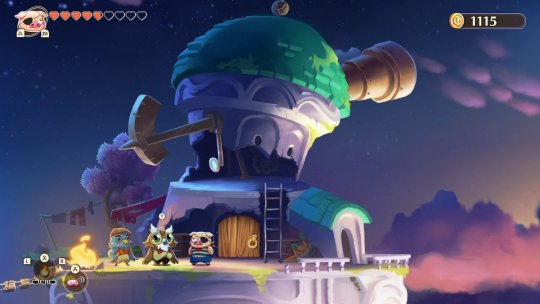
9. Monster Boy and the Cursed Kingdom (PS4/Xbox One/Switch/PC later) - There are plenty of sidescrolling indie metroidvania throwbacks these days. Oddly, there’s also been a fair few games in the oft overlooked Wonder Boy vein lately, the series Monster Boy belongs to. There aren’t a lot of downright pleasant games made in this style lately though, and pleasant is the perfect word to describe the time spent exploring this game. The visuals are absolutely gorgeous, the soundtrack is second only to Celeste this year, and the game somehow manages to feel like playing a Master System game without all of the drawbacks a statement like that would normally entail. What holds this game back from true greatness for me is that some of the later dungeon and boss designs are remarkably unclear in their progression, mostly the haunted mansion area. That said, these are relatively small complaints in a surprisingly large adventure, and the different animal abilities are truly brilliant. Monster Boy occupies the same space for me as last year’s truly incredible SteamWorld Dig 2, and if that doesn’t sell you on the game then nothing will.

8. Yakuza Kiwami 2 (PS4) - Everything stated above in the Honorable Mentions section applies here; Yakuza is a series about lovable handsome crime boys playing the role of boy scouts in their community, if the boy scouts kicked motorcycles at bad guys. I will say that Kiwami 2 never approaches the pure brilliance that was Yakuza 0, but most of that can largely be attributed to the fact that this game is a remake of a 12-year-old video game from two console generations ago. And don’t let that statement deter you; the story is as engaging as ever, and Kiwami 2 also shares with 0 the most fun game within a game I’ve ever played - the cabaret club management sim, which tasks you with recruiting hostesses to take on an evil circuit of club owners in a tournament of taking money from lonely Japanese businessmen. It’s as absurd as it sounds, and far more engaging than it seems, which kind of summarizes the series as a whole. My only caveat with this entry is that I would consider it absolutely crucial to play through 0 and Kiwami 1 before this, as there are some emotional seeds planted in those two games that come to tear-jerking fruition here.
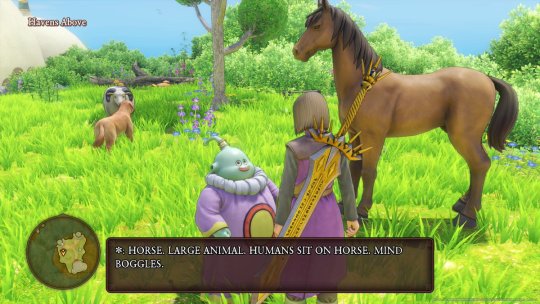
7. Dragon Quest XI: Echoes of An Elusive Age (PS4/PC/Switch later) - With the sales and reception of both this and Octopath Traveler, 2018 seems like the year in which throwback JRPGs came into vogue, and I couldn’t be happier about it. I grew up loving the genre, but post high school my love largely faded for any of them that weren’t Pokemon or Mario adjacent. While I still think there’s a lot of self reflection for the genre to accomplish that Dragon Quest is existentially incapable of doing (as its own design and fandom have prevented it from making any meaningful mechanical progression in decades), DQ11 succeeds in that it’s just a really fantastic video game. Its story is always captivating and repeatedly goes in directions I never expected. Its characters are simple and painted in broad strokes (I mean that in the best way possible) while remaining some of the best written and most engaging party members I’ve ever encountered. And its battle system is oldschool, somewhat archaic and even punishing without ever feeling unfair, and it has just enough new mechanics to constantly give the player a wider swath of options than the series has ever had before without relinquishing the series trademark simplicity. It’s the most I’ve enjoyed a tradition JRPG since Chrono Trigger, and I was never once bored in my 70+ hours of playtime. Really, the only complaint I can level against the game is that the series composer is a monstrous piece of homophobic trash that deserves to be launched into a brick wall via trebuchet.

6. Mega Man 11 (PS4/Xbox One/Switch/PC) - Who would have imagined that a new Mega Man game under contemporary Capcom could end up being great? The soundtrack is extremely disappointing and the Wily stages are a series lowpoint (especially when compared to the previous two Mega Man games), but everything else in this game is operating at heights the series has never previously achieved. The mark of a good Mega Man game is how versatile the robot master’s weapons are within the actual platforming segments, and 11’s level and enemy design are completely built around using these weapons and the new double gear system as well, which allows a player to increase their firepower or slow down time at will. Every ability is not only useful but fun to use as well, even the obligatory shield weapon. Much like what last year’s Sonic Mania did for Sonic, there has never been a better time to try out Mega Man.
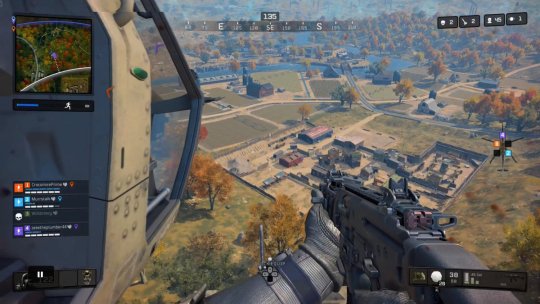
5. Call of Duty Black Ops 4: Blackout (PS4/Xbox One/PC) - The way in which the battle royale genre has overtaken video games is remarkable, though not as remarkable as the fact that a Call of Duty game is being included on one of my game of the year lists. I could go deep into how Blackout feels like a best-of compilation for the genre, or how remarkable it is that it retains the goofy, unpredictable nature of PUBG while actually feeling like a polished video game. But what’s most notable about the game for me is just how much fun I’ve had playing it with my friends. Video games mean a lot to me, and having a game in which our party chat can go from discussing poor life choices made by people we know to yelping as shots soar over our head as quickly as it takes for an armored truck to appear outside the house we’re hiding inside of is something truly special, and it’s something I’ve only encountered with this genre of games. Blackout may not add much of its own flavor to battle royale, and what little is there (the perk system and zombies) feels either broken or weirdly inconsequential. But sometimes, a less broken game with a slightly faster pace is all you need to become the most playable game of the genre, as well as the most I’ve ever enjoyed a multiplayer console shooter.
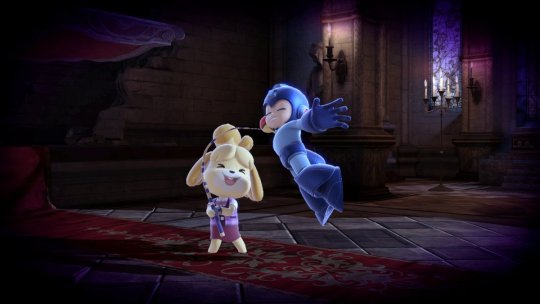
4. Super Smash Bros. Ultimate (Switch) - Smash is my all-time favorite multiplayer series, so the biggest character, stage and music roster to date makes this entry a no-brainer. I mean, I could spend multiple paragraphs absolutely gushing about how excited I am for all of the love the Castlevania series (another all-time favorite video game franchise) has received here alone. And that’s kind of the point. From Isabelle’s accidental murder sprees to K. Rool’s big belly rude boy moveset to Kirby sporting a beard after eating Solid Snake, with Ultimate it feels like nearly anyone that has ever played a video game can find something within that brings a smile to their face. And this is to say nothing of the over 1200(!) “spirits” in the game, all referencing even smaller and more obscure video game things. Will the game have an interesting competitive scene? I think so; I’m no pro, but the game feels so much better to me than any game in the series post Melee. Only time will tell how fun of a tournament game Ultimate ends up being, but as a celebration of the medium as a whole, this is a love letter to nearly all corners of the industry, no matter how niche. And that’s where my love of Super Smash Bros. has always stemmed from - its unflinching love and celebration of the things in my life that I love and want to celebrate. Plus, there’s Castlevania stuff in this one.

3. Tetris Effect (PS4) - Positivity in my life has been in short supply the past couple of years. To be more straightforward, the world has been an absolute fucking nuclear wasteland of hopelessness for the past couple of years. Hell, there’s an argument to be made that it’s been on this level for a while, and it’s my privilege that has prevented me from seeing that, which is even worse. My eyes have been opened, they cannot be closed, and while part of me wishes they could be, most of me can only stare with a grim sense of foreboding and wonder where the hell we’re going and how we fix all of this. So, Tetris then.
Tetris is simple and Tetris can be overwhelming. Add psychedelic visuals, spac- Enya-world music and the option to experience it all in virtual reality, and you have something simple, something overwhelming, and something oddly powerful. To say I had an emotional response to Tetris Effect is an oversimplification. Losing myself inside of my VR headset to clearing lines while dolphins made of light surrounded and splashed around me was beautiful, ridiculous, cheesy and, somehow, empowering. I’m under no illusion that the world is going to get better while I hide inside, literally blind to everything going on around me, and no one should be. But the best art never was able to save us; it reminds us of what there is to lose and why the things we love are worth fighting for while also giving us the strength to do so. This sounds like a lot for what basically amounts to Tetris with cool music and visualizers, and I get that. But while writing and editing this piece, not only do I not feel like any of this has been hyperbolic per my experiences, re-reading my own words really just makes me want to play some more damn Tetris Effect.

2. Celeste (PS4/Xbox One/Switch/PC) - If Tetris Effect is your overly positive friend that can seemingly never be brought down by anything, Celeste is the friend that’s been through more than you could ever imagine and came out through the other side a better person, and not only knows you can as well, but actively pushes you to be the best you can be. This is both narratively true, as the surprisingly great story deals with depression and self-loathing and overcoming anxiety, but also what the game beats into you through your own act of playing it. Well, “beats into you” might be putting it lightly; “gently yet forcefully stabbing into you” is a bit more accurate. Yes, the game is an unbelievably hard platformer (at least on the B and C side levels), and it does take a lot of inspiration in its design from fellow platformer classic Super Meat Boy. But while Meat Boy makes your repeated deaths part of the punchline, Celeste prefers those failures to be recontextualized as experiences to be learned from. “You’re going to beat this level, and you’re going to beat this game. Just keep trying.” is what Celeste wants you to take from its harsh design. And maybe that kind of motivation doesn’t work for everyone, but the people that stick with the game found what will go down as one of the all-time greats in the genre, and certainly one of the best games of the decade.
Oh, and the soundtrack is fucking incredible too.
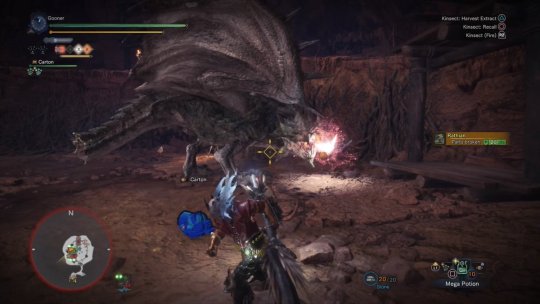

1. Monster Hunter World (PS4/Xbox One/PC) and Monster Hunter Generations Ultimate (Switch) - I knew something special was happening when I saw multiple Playstation friends who usually only play Call of Duty and sports games devoting dozens (or even hundreds) of hours to Monster Hunter World this year. I was skeptical, having tried to get into the series previously on the 3DS, but something just clicked this time that hadn’t before, and soon I was farming Nergigantes for entire evenings. The game was full of nothing but memorable moments, but realizing for the first time how the insect glaive worked and flipping through the air whacking a giant electric flying squirrel as we were both being chased by a fire breathing t-rex was the most out of control I’ve ever felt playing a video game while simultaneously being the coolest thing I’ve ever done in a video game. And to revisit that same scenario over a hundred hours later, armed with the knowledge that only experience can give of how to actually control my insect glaive flips, was one of the most rewarding experiences I’ve ever had. All of the knowledge gained from World was then taken to MHGU on the Switch later this year, where my girlfriend and I put over 200 hours in and still have not seen all of the content within. If two grown adults sitting in a hotel room and screaming with delight when they see how cool the weapons they can forge from hunting a bubble dragon are isn’t an indication that their families should seek help, it means that Monster Hunter is pretty great.
So which game is better? My heart of hearts tells me World wins out by an inch for its extremely intelligent streamlined design and accessibility, but MHGU has dozens and dozens (and dozens and dozens) of different monsters to hunt and hundreds of weapons and armor sets to choose from, and having a full blown Monster Hunter on a portable with a decent screen and dual analog sticks is a great argument for the Switch entry. Really though, it doesn’t matter; these are both amazing games, and I wanted to give them both their due without using two slots. If weirdos on your friends list you haven’t talked to since high school who usually only buy FIFA can fall in love with Monhun, so can you.
0 notes
Link
DETROIT, Michigan — After Hillary Clinton lost the Rust Belt to Donald Trump, some Democrats argued that it would take machismo to win back white, blue-collar men. But this year’s midterm election looks set to prove them wrong. In 2018, it’s women who are poised to deliver the region for Democrats.
Women candidates like Gretchen Whitmer, the Democrat expected to make it to the governor’s mansion; Mari Manoogian, a Democrat running for state representative; and Mallory McMorrow, also a Democrat, running for the state Senate are all on the ballot in Michigan, the heart of the Rust Belt. And all have a strong shot at winning.
Whitmer is up by 12 points in the polls against Republican Bill Schuette. She’s running on competence and follow-through in a state where Republicans have neglected key infrastructure — one of her campaign messages is “Fix the Damn Roads.”
“What people in Michigan want is someone who does what they say they’re going to do, who is real and stays focused on the issues that matter to families,” Whitmer told me at a Dearborn campaign event earlier this month. “It’s not about macho, it’s about getting things done.”
Whitmer and other women running are showing that bringing their experiences as women to the campaign trail doesn’t have to be “identity politics,” at least not the way critics use the term. They’re pitching themselves as different from what’s gone before, in ways that include, but aren’t limited to, their gender.
“For me, it’s about more than just being a woman,” the 26-year-old Manoogian told me about her run for the statehouse. “It’s about being a young woman and a product of the community.”
Voters — especially women clamoring for a change from Trump — are listening.
“I’m tired of the masculine leadership,” said Kim Boudreau Smith, a Birmingham, Michigan business coach who didn’t vote for Clinton in 2016, when Manoogian and McMorrow visited her home on an October canvassing outing. “We really need a lot, a lot of changes.”
In the wake of the 2016 election, many pundits coalesced around one explanation for Trump’s win: He’d been unexpectedly successful at pulling white working-class voters away from the Democratic Party, especially in areas of Michigan, Ohio, Wisconsin, and Pennsylvania that had gone for Obama in 2008 and 2012.
“In the end, the bastions of industrial-era Democratic strength among white working-class voters fell to Mr. Trump,” wrote Nate Cohn in the New York Times, under the headline, “Why Trump Won: Working-Class Whites.”
As those surprised by Trump’s victory continued to dissect the election, many focused on a particular slice of white, working-class voters: men in the Rust Belt who worked in (or who had recently lost) manufacturing jobs.
President Trump introduces Ken Wilson, an employee of H&K Equipment, to supporters at a rally in Coraopolis, Pennsylvania, on January 18, 2018. Jeff Swensen/Getty Images
“If there’s such a thing as a Trump Democrat,” Edward McClelland wrote in an op-ed at the Washington Post, “he’s exemplified by Bill Peek, a UAW member who worked 41 years for General Motors at the Saginaw Central Foundry.” He quoted Peek praising Trump’s toughness — “All of our businesses should be penalized if they move their plants overseas. He’s gonna put his foot down.”
“He’s ahead of Clinton in my book,” Peek told McClelland. “He’s a businessman. If anybody’s gonna get us out of here and get us back on our feet like it should be, he’s the one.”
McClelland wasn’t the only one to focus on post-industrial Michigan to explain Trump’s win. For a 2017 Atlantic story calling on the Democratic Party to recommit to the white working class, Franklin Foer spent time in Macomb County, outside Detroit.
“Once upon a time, Macomb was a testament to the force of the New Deal, a vision of middle-class life made possible by the fruits of American industry,” Foer wrote. “But over the years, Macomb grew distant from the party, and then furious with it.”
Trump beat Clinton by 12 percentage points in Macomb, and Foer uses the county as a springboard for the argument that Clinton lost the election in part because she paid too much attention to the ideals of the “cultural left” — which seeks “the validation of minorities and women in the eyes of the national culture” — at the expense of the “economic left” whose populism was more appealing to working-class white voters.
Foer doesn’t believe Democrats necessarily need male candidates to appeal to the disaffected of Macomb — his example of the party’s potential populist future is Elizabeth Warren. But he does argue that Democrats may have been focusing too much (or at least in the wrong way) on gender and racial justice, thus alienating voters who don’t like hearing about such things.
And he quotes Bernie Sanders’s now-famous post-election criticism of identity politics (and, by extension, of the Clinton campaign): “It is not good enough for someone to say, ‘I’m a woman! Vote for me!’”
The message of much analysis of the 2016 election, then, is as follows: Hillary Clinton, the first woman presidential nominee from a major party, focused too much on her own gender and on “cultural” issues generally, at the expense of the issues that really matter to white working-class voters in places like Michigan, and especially white, working-class men.
Donald Trump, meanwhile, was the macho man the Rust Belt craved. To beat him and his ilk, Democrats should feed that craving — either with white, male candidates (Joe Biden comes up a lot) or, at the very least, by not talking so much about gender and race.
But a look at Michigan reveals the shortcomings of this narrative. It’s possible to talk both about so-called cultural issues and about economics — and it’s possible to talk about the importance of women in politics without saying it’s the only thing that matters. (Something that, it’s worth noting, Clinton never did.)
The women running in Michigan aren’t saying, “I’m a woman! Vote for me!” But they are campaigning on their unique experience, which includes their gender. And rather than recoil in horror from “identity politics,” voters are seeing something appealingly different.
In 2013, when Whitmer was the minority leader of the Michigan State Senate, Republicans backed a bill that required women to purchase an additional insurance rider if they wanted coverage for abortion. The bill contained no exception for pregnancy resulting from rape.
In explaining her “no” vote, Whitmer told a personal story she had never shared publicly before.
Gretchen Whitmer speaks with community members and organizers in Detroit, Michigan on December 19, 2017. Ali Lapetina for The Washington Post via Getty Images
“Over 20 years ago I was a victim of rape,” she said in a speech to the state Senate. “If this were law then, and I had become pregnant, I would not be able to have coverage because of this.”
“I am not the only woman in our state that has faced that horrible circumstance,” Whitmer went on. “I am not enjoying talking about it. It’s something I’ve hidden for a long time, but I think you need to see the face of the women that you are impacting by this vote today.”
[embedded content]
Despite Whitmer’s emotional speech, the measure passed. “I bared my soul to the world and it didn’t make a single difference in the vote,” Whitmer told me on the way to a rally with Bernie Sanders in Ann Arbor this month. “I went to bed incredibly depressed that night.”
But soon, she said, women and men around the state began calling and emailing her office, and posting on Facebook, to tell their own stories.
“We were just overwhelmed by the enormous supportive reaction,” she said. “I didn’t change that vote that day, but I added my voice to a conversation that was long overdue.”
The moment in some ways anticipated the spread of the #MeToo movement, to which Whitmer contributed last year with a video she posted on Facebook.
“I shared my story of sexual assault during a tough debate at the Capitol,” she says in the video. “But I did it because women’s voices weren’t being heard.”
Whitmer has also been outspoken about the sexual misconduct allegations against Supreme Court Justice Brett Kavanaugh. On the day Christine Blasey Ford testified before the Senate Judiciary Committee that Kavanaugh had assaulted her when both were in high school, Whitmer tweeted simply, “I believe Dr. Ford.”
“Anyone who’s a survivor knows it’s a lifelong scar you carry,” Whitmer told me. “It’s painful to see another woman discounted,” she added, “but it’s also something that added more energy to the work that I’m doing as a candidate.”
There was a time when talking about something like sexual assault was considered dangerous for female candidates.
“For women historically, the challenge has been that the expectations of candidates and officeholders have aligned more often with masculine traits and masculine areas of expertise,” said Kelly Dittmar, an assistant professor of political science at Rutgers University and co-author of the book A Seat at the Table: Congresswomen’s Perspectives on Why Their Representation Matters.
“I think that’s changing this year,” she said. “Women are really pushing the boundaries.”
Women candidates in this election cycle are pioneering a new way of running for office, Maeve Coyle, deputy director of campaign communications for Emily’s List, which supports pro-choice Democratic women and has endorsed Whitmer, told me.
“They’re not shying away from their personal stories, and they’re not following any specific formula to what a candidate should or shouldn’t look like,” Coyle said. “We have candidates all across the country who are kind of just throwing the playbook out of the window.”
That doesn’t mean they’re saying voters should cast their ballots based on gender alone. Rather, Dittmar explained, women candidates like Whitmer are saying, “gender is among the value-added pieces of me that I bring. It’s not just being a woman, it’s living my life as a woman and all of the experiences that brings.”
Whitmer isn’t the only Michigan candidate taking this approach. For Mari Manoogian, a former State Department employee and Birmingham native running for the state House of Representatives there, gender is just one factor she believes gives her a unique perspective on her state’s problems.
Michigan State House of Representatives candidate Mari Manoogian in Birmingham, Michigan, on October 19, 2018. Anna North/Vox
The issues facing Michigan, from education to health care to the environment, would benefit from fresh ideas, and one way to introduce those, Manoogian says, “would be having a different kind of representation, whether that’s young people, or women, or homegrown people.”
“That’s, to me, why I think it’s really important to me to have diverse leadership,” she said.
For McMorrow, a 32-year-old industrial designer who’s worked for Mazda and Mattel, 2016 was a wake-up call that more women needed to get involved in politics. “It wasn’t just that Trump got elected, it’s that we had somebody who was openly bragging about sexual assault get elected.”
“That was really a push that got a lot of people in,” she said, speaking of the unprecedented numbers of women running for office in the wake of the 2016 election. “But now I think the reasons we’ve all stayed in and found success have been very different.”
She believes she brings something new to the table in Michigan, but it’s as much about her background as her gender. “My skill set as an industrial designer and the way that I think about solving problems is gravely missing from our political process,” she said.
Manoogian, McMorrow, and Whitmer are spending plenty of time talking with voters about issues that cut across gender. All have promised to work to fix the state’s pothole-ridden roads. All have pledged to help clean up the water — the state, still reeling from the Flint water crisis, now faces another potential threat to citizens’ health as toxic chemicals called PFAS have been found in water consumed by more than 1.5 million residents.
“Who the governor is impacts our lives every single day, from when we turn on the tap water and brush our teeth, to when we drive our roads to take our kids to school, to the schools that they attend,” Whitmer said in a speech at the Arab American Chamber of Commerce in Dearborn on October 19.
Polls suggest that, at least in Michigan, women candidates’ pitches are working on voters. Though her margin has shrunk in some polls, Whitmer is favored to beat her Republican opponent, Bill Schuette, who has the endorsement of President Trump.
Michigan, where Republican Gov. Rick Snyder is departing due to term limits, was one of the top states targeted for pickup this year by the Democratic Governors’ Association. Snyder is unpopular because of his handling of the crisis in Flint, and voters may be soured on Republicans as a result. But the Democrats also like their chances due to Whitmer’s strengths as a candidate.
“You’ve got to run the campaign that is authentic to you,” said David Turner, deputy communications director for the Democratic Governors Association. “She is clearly comfortable in her own skin, she knows exactly why she’s running, who she’s running for, and what she’s going to do to help them.”
Meanwhile, Democrats hope to gain control of the Michigan House of Representatives, and believe they may have a shot at the state Senate as well — and women candidates are a big reason why. Democrats are running a woman candidate in 10 of the top 13 target races in the House, according to the Detroit News, and in seven of the nine top races in the Senate. Among these key races are Manoogian’s, against Republican David Wolkinson for an open Republican seat, and McMorrow’s, against Republican incumbent Marty Knollenberg.
Michigan State House of Representatives candidate Mari Manoogian, left, and Michigan State Senate candidate Mallory McMorrow, right, canvassing in Birmingham, Michigan, on October 19, 2018. Anna North/Vox
In some cases, Democratic women have been able to appeal to groups and voters across the aisle. Republican Women for Progress, a PAC started by Republican women who supported Clinton in the 2016 election, has endorsed two Democratic women from Michigan, Haley Stevens and Elissa Slotkin, for Congress. The endorsement “was inspired by us talking to Republican women in these districts where they said there was just no way that they could vote for the Republican,” Meghan Milloy, co-founder of Republican Women for Progress, told the Detroit Metro Times.
“We think the best thing that we can do for the party and for the country right now is to make sure there are good women — Democrat or Republican — that are elected to office and who can serve as a check on this administration and on the president,” she added.
It’s not just Michigan; around the Rust Belt and the Midwest, Democrats are betting on women to win. In Minnesota, Ilhan Omar is favored to become one of the first Muslim women elected to Congress. In Pennsylvania, a record eight women, seven of them Democrats, are running for congressional seats. In Ohio, women make up 44 of 99 Democratic candidates for the state House of Representatives, and seven of 17 candidates for state Senate. Six of them recently got together to form Ohio Women Lead, a group that has produced a video ad and is working on get out the vote efforts.
“In prior elections, women may have been less likely to talk on the campaign trail about what it’s like to be a mom and balance family and work,” Rep. Kristin Boggs, who is leading the group, told the Columbus Dispatch. “With these candidates, our families have been such a motivating factor about why they’ve gotten into the election. They are actively talking about it, using it to connect with other women who are just as frustrated with the state of affairs.”
Meanwhile, across the country, women likely voters are favoring Democrats at even higher rates than usual. In a September survey, women in Michigan supported Democrats by more than 20 percentage points.
Historically, women tend to vote their party, not their gender, Dittmar said. However, there is evidence that having a woman on the ballot can increase women’s enthusiasm and engagement in the election, if they share her party, she added. “I do think that we are seeing that this year.”
One woman who’s planning on voting for a Democratic woman is Smith, the Michigan business coach, who said, “Gretchen has my vote big-time.”
“I’m not going to just go vote because all women are running,” she explained. “It takes the right women.”
Other Michigan voters echoed her views.
“I think whatever gender that supports the community, that is the gender we should go with, whether woman or man,” Vann Glover told me as she shopped at Detroit’s outdoor Eastern Market on October 20.
“But it’s always good to see a woman take the job,” she added. “I think we’re a little more sensitive to people and their needs.”
A loyal Democrat, Glover said she planned to support Whitmer in November.
Jeanne Royal, meanwhile, was still doing her research for the midterm election, she told me at Eastern Market. But she was planning to vote this year for the first time ever.
“I used to have a view that my vote doesn’t matter. But I see how a couple little votes didn’t matter and we got stuck with — you know,” she said, laughing.
Royal was excited to see a potential “year of the woman” this year.
“I like that, that’s awesome,” she told me, pumping her fist in approval. “Women have been oppressed throughout civilization,” she said. “It’s good to see that my species is rising.”
In the wake of the 2016 election, some analysts assumed that beating Republicans would require copying Trump’s appeal to white working-class masculinity. But Trump didn’t just run as a macho man. He also ran as a change candidate — a business executive and TV star who pledged to “drain the swamp” in Washington. Two years later, the candidates best placed to run on change may be not men, but women.
It’s not just women who think so. McMorrow said one male voter recently told her, “I voted for Trump because he’s different, and I’m going to vote for you because you’re different.”
Hillary Clinton failed to carry Michigan for a number of reasons, some of them unknowable. There was a decades-long history of sexist news coverage that helped convince American voters she was “unlikeable.” There were her own admitted shortcomings as a politician. There was her failure to spend much time in the state in the general election campaign.
But Clinton, despite her historic status as the first woman major-party nominee, also looked to many voters like business as usual — the wife of a former president, she struggled to win over those who opposed his policies. And when Trump was caught on tape bragging about his ability to grab women “by the pussy,” he was able to bring up Bill Clinton’s allegations of sexual assault, even bringing some of Clinton’s accusers to a debate.
Whitmer has made her career in state government and is familiar to many voters. Still, she, McMorrow, and Manoogian likely represent more of a departure than Clinton ever could — especially now, when women are watching the fallout from Trump’s election.
This year, Dittmar said, “You’re seeing women say, I can’t afford to sit on the sidelines because of what is happening in politics.” That’s a different environment than the one that prevailed in 2016 — and it might produce a different result.
Whitmer, McMorrow, Manoogian and others aren’t campaigning solely on their gender, or on opposition to Trump, or on #MeToo. But they are campaigning on offering voters something different than what’s gone before.
Mari Manoogian at her campaign headquarters on October 19, 2018. Anna North/Vox
“When I think about Mallory or I think about this phenomenal ticket that’s come together,” Whitmer told me, “we all got here not because we had this master plan, but because we were tired of the status quo.”
“We all came from different directions,” she said, “but I think the similarities are, we grit our teeth and do the work.”
Original Source -> Trump won the Rust Belt with macho. These women hope to win with change.
via The Conservative Brief
0 notes
Text
The Push to Make French Gender-Neutral
New Post has been published on http://usnewsaggregator.com/the-push-to-make-french-gender-neutral/
The Push to Make French Gender-Neutral
“My homeland is the French language,” author Albert Camus once wrote—and many French people would agree. That’s why any attempt at changing the language is often met with suspicion. So the uproar was almost instantaneous when, this fall, the first-ever school textbook promoting a gender-neutral version of French was released.
It was a victory for a subset of French feminists who had argued that the gendered nature of the language promotes sexist outcomes, and that shifting to a gender-neutral version would improve women’s status in society. Educating the next generation in a gender-inclusive way, they claimed, would yield concrete positive changes, like professional environments that are more welcoming to women.
Many others found this idea outrageous. They complained that implementing it would badly complicate education, and that there’s not enough evidence that changing a language can really change social realities. Clearly in the second camp, the office of Prime Minister Edouard Philippe announced this week that it’s banning the use of gender-neutral French in all official government documents.
In French, pronouns, nouns, and adjectives reflect the gender of the object to which they refer. So, le policier is a policeman; la policière is a policewoman. The language has no neutral grammatical gender. And there are many nouns (including those referring to professions) that don’t have feminine versions. So, a male minister is le ministre and a female minister is la ministre. What’s more, French students are taught that “the masculine dominates over the feminine,” meaning that if you have a room full of ten women and just one man, you have to describe the whole group in the masculine.
Feminists who believe that these features of the French language put women at a disadvantage disagree about how best to remedy them. Most recommend creating feminine versions of all professional nouns and/or using neutral nouns whenever possible. Many also recommend a grammatical tool that consists of adding a “median-period” at the end of masculine nouns, followed by the feminine ending, thus indicating both gendered versions of every noun (like musicien·ne·s, which would read as “male musicians and female musicians”). Some have even recommended creating a gender-neutral pronoun (the equivalent of how “they” is sometimes used in English, or “hen” in Sweden). These and other recommendations have collectively become known as “inclusive writing.”
Many linguists I spoke to stressed that changing a language doesn’t guarantee a change in perception; this leads some of them to say that inclusive writing just isn’t worth the trouble. But at least one major school of linguistic thought concludes that language and perception are intimately related.
Proponents of linguistic determinism argue that your language determines and constrains what you’re capable of thinking. Linguistic determinism is the strong flavor of the Sapir-Whorf hypothesis—the idea that your language influences how you think. This hypothesis was popular in the 1940s, but it was deemed incorrect by the linguistic community in the 60s and 70s. “Languages differ essentially in what they must convey and not in what they may convey,” argued linguist Roman Jakobson. It’s not that speaking French makes it impossible for you to conceive of something as gender-neutral, he suggested, but that the language forces you to think often in gendered terms. Whereas in English you can say “I’m having dinner with my friend” without indicating whether the friend is male or female, in French you have to indicate—and therefore think about—the friend’s gender by using either a female or male noun. Today, some still believe in the Sapir-Whorf hypothesis, and it enjoyed some popular attention last year after being featured in the movie Arrival.
Some scientific research does seem to suggest that gendered languages like French lead to more sexist perceptions than gender-neutral ones like English. But those studies are limited in that they can’t control for outside factors like culture, which are extremely important in determining sexist attitudes.
“Faced with this ‘inclusive’ aberration, the French language is now in mortal danger.”
In France, this debate traces its roots back to World War I, when men went to war and left women behind to fill traditionally male-dominated positions like chimney sweep or factory worker. The nouns referring to those professions, which previously only had masculine versions, developed feminine ones, to the great horror of French society at the time. But what was tolerable in wartime became unacceptable when men returned from the battlefield, and the question of how to make French gender-neutral was sidelined until the 1970s and ’80s. Efforts at the governmental level to study the possible feminization of French began in 1984 and continued throughout the end of the 20th century, but all proposals were rejected by the institutions that control the codification of the language.
When the French publishing house Hatier released an “inclusive” textbook for children in the third grade this September, it was based on the 2015 recommendations of the High Council for Gender Equality, which had outlined 10 ways to make the French language more gender-neutral. Major conservative publications published op-eds and editorials with headlines such as “Feminism: the delirium of inclusive writing” or “Inclusive writing: the new factory for idiot·e·s.” Many philosophers and scholars came out strongly against what they saw as feminist activism masquerading as linguistic science—and using children as guinea pigs. Emmanuelle de Riberolles, a literature professor in the Picardie region of France, argued that “children should not be dragged into struggles that do not concern them.” Even the Minister of Education, Jean-Michel Blanquer, came out against inclusive writing, explaining that “language is a bedrock of life that we owe to children” and that it “must not be instrumentalized, even for the best of causes.”
The French Academy, the highest council for matters pertaining to the French language, issued a strong statement, saying that the additional grammatical complications of inclusive writing would lead to “a disunited language, disparate in its expression, creating a confusion that borders on illegibility.” What’s more, “faced with this ‘inclusive’ aberration, the French language is now in mortal danger, a fact for which our nation is now accountable to future generations.” The statement also warned that inclusive writing would “destroy” the promises of the Francophonie (the linguistic zone encompassing all countries that use French at the administrative level, or whose first or majority language is French). The Francophonie is arguably one of France’s most successful postcolonial tools of global engagement, with 84 member states and governments that account for 274 million French speakers and represent one-third of the United Nations’ member states.
Proponents of inclusive writing were not convinced by the Academy’s argument. “It’s laughable,” said Elianne Viennot, a historian and professor of literature. “They [the members of the Academy] never cared about the promises of the Francophonie” and “contempt [for Francophone nations] is still very much rooted in their culture.” She pointed to a famous member of the Academy, Maurice Druon, who, in 2006, said he resented the “absurd feminizations” of French, such as those proposed in Quebec at the time under the influence of the “women’s leagues of the United States.”
In fact, “France stands out from other countries by its resistance to feminization,” according to Elizabeth Dawes, a professor of French studies at Laurentian University in Canada who studied inclusive writing. The boldest innovations in inclusive writing are being debated in francophone countries; Canada started tackling the question of feminizing professions as early as 1979, and Switzerland and Belgium followed suit in 1991 and 1994 respectively.
Related Stories
The supporters of inclusive writing say the strong institutional pushback in France is rooted in a misunderstanding of what language is meant to do; it should be a vector for social progress, they argue. “Language is … the space where we must inscribe societal transformations,” said Raphaël Haddad, a linguist and founder of the communications agency Mots-Clés. Responding to critics who complain about unduly politicizing language, Haddad argued that language is already inherently politicized—and he set out to prove it.
Haddad and his colleagues at Mots-Clés recently commissioned a study from Harris Media that sought to measure the French public’s awareness of inclusive writing and what they thought of it. An experiment asked respondents to spontaneously name famous French TV personalities. The question yielded a higher percentage of female names when it was phrased in a gender-inclusive way than it did when phrased in a gendered way. In either case, however, respondents overwhelmingly named men.
An earlier study, “Does language shape our economy? Female/male grammatical distinctions and gender economics,” suggested a link between gendered languages and labor-force participation rates for women. It found that having a gendered grammar system is associated with a lower female labor-force participation rate compared to countries without gendered languages. But this subject is still on the margins of cognitive science and linguistics research, and critics of inclusive writing say that not enough work has been done to prove conclusively that changing a language will improve gender equality.
Nevertheless, this May, Haddad and his firm released an online manual that codified inclusive writing for corporations and institutions. He believes that inclusive writing can successfully help businesses deal with gender inequality. (According to the World Economic Forum’s 2017 Global Gender Gap Report, France ranks 11th in the world in terms of overall gender equality, but 64th in the world in terms of women’s economic participation and opportunity. The Observatory of Inequalities, a private organization, estimates that French men continue to earn, on average, 22.8 percent more than women.) A recent initiative by the Minister of Labor, Muriel Pénicaud, seems to take Haddad’s perspective seriously; on October 10, her ministry released an official guide for businesses that presents inclusive writing as a way of tackling gender inequality in the workplace.
There are other signs that the campaign to normalize inclusive writing is working: In late 2016, Microsoft Word released the newest version of its platform, which now has an inclusive writing option in French. The company explained that this new feature “targets gendered language which may be perceived as excluding, dismissive, or stereotyping,” and encourages “using gender-inclusive language” when possible. In addition, the French keyboard is getting an “inclusive” makeover: The French Association of Normalization, which coordinates the standards-development process among French businesses, announced that it is designing a new keyboard that will include the median-period. The move will please not only the proponents of inclusive writing, but also the speakers of minority languages in France (like Catalan, Occitan, and Gascon), who have always used the median-period as a phonetic marker.
New keyboards and new school textbooks notwithstanding, it’s incredibly difficult to change a language, as all the linguists I spoke with emphasized. If France is serious about gender equality, there may be more efficient ways to get there than inclusive writing. And while cultural conservatism is definitely involved in the backlash, it’s not the only factor. “Mastery of a complex orthographic system is an important piece of cultural capital,” explained Mark Liberman, a linguistics professor at the University of Pennsylvania, “and people everywhere object to any development that devalues it.”
Original Article:
Click here
0 notes